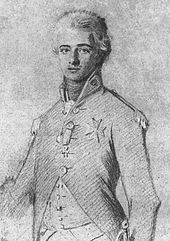Camillo Marcolini
Count Camillo Marcolini-Ferretti (born April 2, 1739 in Fano , † July 10, 1814 in Prague ) was a Saxon minister and general director of the arts.
Life
In 1752 Camillo came to the Saxon court in Dresden as a silver page , because the Elector Prince Friedrich Christian had met his father personally in Rome . It is very likely that he acquired the Italian title of count himself. He succeeded in building the trust and friendship of the young elector and later elector Friedrich August III. to acquire. As early as 1767 he was appointed chamberlain and two years later chief steward . In 1772 he was promoted to the Real Secret Council . In 1778 he received the title of Lord Chamberlain, which he exchanged for that of Head Stable Master in 1799 . Ten years later (1809) he became cabinet minister for the Royal Saxons . In this function he accompanied the king on his escape after the Battle of Leipzig in 1813. He died in 1814 in exile in Prague .
Merits
In addition to his steep political career, he became General Director of the Arts and Art Academies in 1780. From 1774 to 1814 he was director of the Meissen porcelain factory . At his instigation, the Meissen swords mark was additionally marked with a star, the so-called "Marcolini mark", from 1775 to 1814. The Marcolini period is considered to be one of the heyday of the Meissen porcelain manufacture.
In addition to his possessions, including Oberlichtenau Castle , Marcolini also leased landscaping and horticultural areas. The most famous area is the pheasant garden near Moritzburg . Also surrounding ponds, e.g. B. the Bärnsdorfer Großteich , were managed by him. In Moritzburg , within sight of the baroque Moritzburg Castle, was Marcolini's country residence, the Marcolini House .
From 1785 to 1787, Marcolini bought plots of land on Bautzner Strasse in Dresden on the "New Extension". There he wanted to build an agricultural model estate based on the English model with the Vorwerk as its economic center. In addition to fruit, field crops and hops, citrus fruits and mulberries were also grown on the land on an experimental basis. From 1800 he had a hunting lodge built for his wife. It was the Dresden Waldschlösschen , which also included an English park . He also tried to lease the zoo in Annaburg in 1789 and in 1792 suggested the establishment of a horse breeding facility in this zoo.
Marcolini married Baroness Maria Anna O'Kelly on May 4, 1778 , a descendant of Jacob II of England.
literature
- Friedrich August Freiherrn Ô-Bÿrn: Camillo Graf Marcolini, Royal Saxon Cabinet Minister, Chief Stable Master and Chamberlain: a biographical sketch. Dresden: Schilling 1877.
- Heinrich Theodor Flathe : Marcolini, Camillo Graf . In: Allgemeine Deutsche Biographie (ADB). Volume 20, Duncker & Humblot, Leipzig 1884, p. 306.
- Rainer [G.] Richter: The art in Saxony under the influence of the Minister Camillo Graf Marcolini . In: Keramos. Journal of the Society of Ceramic Friends V. , 1989, issue 126, pp. 7-26.
- Karla Schneider: Marcolini or how to become a favorite , Munich, Vienna: Carl Hanser Verlag, 2007, ISBN 978-3-446-20905-3 .
- Hermann Jedding: Meissen porcelain of the 19th and 20th centuries, 1800-1933 . Munich: Keysersche Verlagbuchhandlung, 1981, ISBN 3-87405-133-1 .
- Peter-Christian Wegner: Remarkable motifs on Meissen porcelain from the Marcolini period , Ludwig, Kiel 2016.
Web links
- Palais Bruehl Marcolini
- Adelspalais becomes a city hospital
- Literature by and about Camillo Marcolini in the Saxon Bibliography
Individual evidence
| personal data | |
|---|---|
| SURNAME | Marcolini, Camillo |
| ALTERNATIVE NAMES | Marcolini-Ferretti, Count Camillo |
| BRIEF DESCRIPTION | Electoral Saxon politician |
| DATE OF BIRTH | April 2, 1739 |
| PLACE OF BIRTH | Fano |
| DATE OF DEATH | July 10, 1814 |
| Place of death | Prague |

